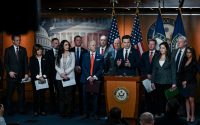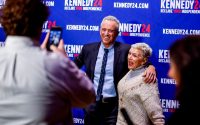San Francisco Residents Tired of City’s Negative Reputation
Soon after Karan Mathur arrived in Brooklyn for a new job last year, New Yorkers couldn’t wait to congratulate him for fleeing San Francisco.
He heard over and over about the abandoned downtown in his former city. The shuttered Nordstrom store that once anchored the retail core, but now symbolizes its decay. The people who stumble along the city’s sidewalks in a drug-fueled haze. The rampant car break-ins leaving puddles of shattered glass.
But that’s only part of San Francisco’s story, Mr. Mathur has been quick to respond. While the city faces disarray in parts of its grim core, he said he’s tried to offer a more complete picture beyond the crime footage that has gone viral on social media and the despair that has been highlighted in regular news reports.
“It’s like going to New York and spending your entire time in Times Square, and your takeaway is, every New Yorker is dressed like Cookie Monster,” Mr. Mathur said. He tells his neighbors that San Francisco as a whole remains stunning and its amenities world-class.
Since the pandemic upended life in downtowns across the nation, perhaps no major American city has suffered as severe a reputational hit as San Francisco has. Residents who had long seen their city as a wondrous jewel of the West Coast, with its culinary delights and sublime natural beauty, are now trying to rebuild the city’s tattered reputation — and finding it a daunting task.
A few years ago, the outsider’s view of San Francisco focused mostly on the city’s roaring, tech-fueled success, including a skyline dotted with cranes and Google buses whisking young software engineers to their posh tech campuses. That image wasn’t entirely accurate, either, glossing over income inequality, steep housing costs and homelessness.
But as remote work has upended the thrum of daily life, the city has become a poster child for petty crime, public drug use and tent encampments, even though the quality of life in most San Francisco neighborhoods hasn’t significantly changed. In a deeply polarized country, conservatives have found a ripe target in the woes of liberal San Francisco.
The narrative threatens the city’s recovery of lost convention and tourism traffic. And it has become enough of a problem that the city recently enlisted a public relations firm to try to convince the world that the city isn’t doomed. The effort comes in the run-up to the Asia-Pacific Economic Cooperation conference in November, which is expected to draw President Biden, about 20 other heads of state and 1,200 corporate chief executives from around the world.
“The Tenderloin is a disaster. The Financial District has issues. But let’s have perspective here,” said Jason Mandell, a public relations executive who has lived in San Francisco for 26 years and was hired by the conference organizers to counter the persistently negative narrative. (Fox News, which broadcasts reports on the city’s troubles almost daily, recently highlighted efforts to improve the city’s image with the headline, “San Francisco hellhole hopes for PR makeover.”)
Like any city, San Francisco is a complicated place with many story lines. It has a property-crime epidemic, but low rates of violent crime. It has a homelessness crisis and is pleading with a federal court for more leeway to clear tent encampments, but according to the most recent homeless count, there was a 15 percent drop in the homeless population living on its sidewalks between 2019 and 2022. Its downtown recovery has been glacial, but its unemployment rate is low at 3.6 percent.
The city has a record-high 31 percent office vacancy rate, and some prominent retail departures have drawn attention. But optimists say they hope these trends will open up space in the city for artists, nonprofit groups and possibly colleges.
There is no way to positively spin the drug crisis; 84 people died of overdoses in August, putting the city on track to tally 845 drug deaths this year, the most on record.
But there are hopeful signs. Several new parks have opened in the city in recent years, including Tunnel Tops, where families flock on sunny weekends to picnic, stroll and take in views of the bay. The city has closed a couple of scenic thoroughfares to cars, most notably John F. Kennedy Drive in Golden Gate Park, where people can now bike, roller skate or play a weathered grand piano.
While downtown struggles, previously sleepy neighborhoods are thriving. Thousands of people packed Irving Street in the Sunset District this month for the inaugural Sunset Night Market, eating Asian delicacies and watching ballerinas dance in the road.
This fall, the chef Tyler Florence will turn two cafes in Union Square into Miller & Lux Provisions locations, one of them offering baked goods including “the most ethereal croissants you’ve ever tasted” and one offering rotisserie chicken and rosé on tap.
Mr. Florence said he believes the harsh national attention has mostly been warranted, but he sees the beginnings of a strong recovery.
“The pandemic, and work-from-home culture, and fentanyl on top of that — it was this epic storm that ripped through San Francisco,” Mr. Florence said. “Every piece of bad news we’ve gotten, every negative headline, we sort of deserved. But I think we’re healing, and healing quickly.”
Within San Francisco, residents are battling over the image of their beloved city.
In August, a land use commissioner tried to organize a “Downtown Doom Loop Walking Tour,” in which participants would have paid $30 to see close-up views of “urban decay” in the Tenderloin neighborhood, where homeless encampments and drug use are most visible.
After the idea met with harsh criticism, and was seen as an attempt to exploit the struggles of people living on the street, the official, Alex Ludlum, resigned from his post and canceled the tour.
Del Seymour, known as “the mayor of the Tenderloin” for his longtime presence as a social service provider in the neighborhood, responded by giving his own walking tour to 117 people.
Mr. Seymour, 76, said it was true that city officials had not done nearly enough to clear sidewalks in the Tenderloin for neighborhood residents, many of them immigrants, children and seniors. But for his tour, he showed participants a more nuanced picture, pointing out the Tenderloin’s nonprofit offices, affordable housing complexes and bodegas.
“And just the joy,” Mr. Seymour said. “This is a very loving neighborhood. The majority of people in the Tenderloin are not involved in the street mess we have.”
During the pandemic shutdowns, San Francisco saw an exodus not only of downtown workers but also of residents. Almost 50,000 people moved out, many of them taking advantage of remote work options to move to cheaper locales, reducing the city’s population to 832,000.
But the city still draws newcomers, including people working in the artificial intelligence industry, which has been growing in San Francisco and which city leaders hope will be a saving grace.
Angela Hoover, 25, moved from Miami in July to run her A.I. company, Andi. Wanting to be where most of the action was occurring in her budding industry, she found a place near the panhandle of Golden Gate Park. She said she loved the small-town feel of her neighborhood, where she’s gotten to know her local barista and grocer.
“So many of my friends told me I was crazy for moving to San Francisco — it’s unsafe, it’s filthy, it’s going down the tubes,” she said. “My experience has been the opposite. The beautiful neighborhoods, vibrancy and positivity — that message isn’t getting out there.”
Bobby Pierce and his wife, Leanne, are raising their toddler, August, in the Richmond District, a San Francisco neighborhood popular with families for its proximity to Golden Gate Park, Ocean Beach and eclectic shops. Mr. Pierce, who grew up in rural Ohio, said people there like to criticize San Francisco for its fentanyl deaths, homelessness and economic struggles, even though those problems exist everywhere, including Ohio.
“When I was growing up, the meme of San Francisco was that it was this ungodly gay place, and before that, it was hippies,” said Mr. Pierce, 36. “It’s never had a nationally savory reputation, I suppose, which is maybe what draws me to it.”
James Falino, 28, a consultant for environmental nonprofits, said he moved to San Francisco from New York five years ago for its relaxed vibe, proximity to nature and thriving L.G.B.T.Q. communities. But when he visited New York over the summer and the topic of San Francisco came up, he immediately felt defensive.
When people learned where he lives now, they responded with a facial expression that he described as “aghast.”
Then came a whispered, “Are you OK?”
“I am,” he assured them. Again and again.


